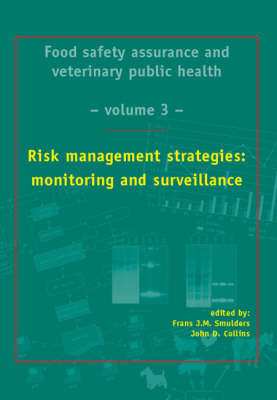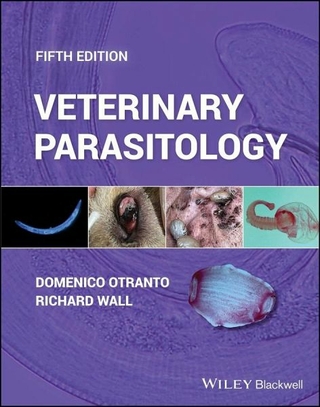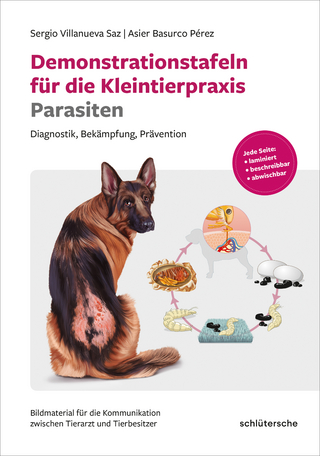
Risk management strategies: monitoring and surveillance
Wageningen Academic Publishers (Verlag)
978-90-76998-07-7 (ISBN)
- Titel nicht im Sortiment
- Artikel merken
For the veterinarian, monitoring and surveillance represent the best means of ensuring sustainable animal production at a time when consumer demands reflect awareness that many of the hazards associated with food animal production can be minimised or avoided through proper management at the primary production level. Preventive medicine and quality and safety assurance programmes are primarily based on knowledge of the existing strengths and weaknesses of the clients' enterprise and their ability to enact effective intervention measures. Accordingly, the food animal veterinarian relies upon effective monitoring of current performance and herd health status both for the purpose of maximising efficiency of production and providing an assurance that the primary food product meets required health standards in terms of freedom from those agents of concern that have their origin on the farm. These agents include foodborne parasites, pathogenic bacteria, some of which display a resistance to antimicrobial agents, contaminants of environmental origin, as well as chemical and pharmaceutical residues. The more successful these hazards are addressed at the farm, the better the quality and safety of the final product and their marketing possibilities will be. Communication between the primary producer and the food processing industry that facilitates real-time exchange of information on these issues is essential for the practice of preventive medicine at the herd and flock level. Integrated food chain quality and safety control programmes, when linked to such monitoring and surveillance principles in regard to both human and animal health, represent the means of achieving sustainable food animal production on a global scale, in line with the conclusions of WTO and EU. Volume 3 of the "Food Safety Assurance and Veterinary Public Health" series addresses this collaborative approach. Leading international experts from academia, industry and governmental institutions have been identified to deal with the various aspects of this collaborative approach in monitoring and surveillance.
Preface 15; Keynote contributions 17; Risk management strategies in food safety: some issues for the EU 19; Patrick G. Wall; Summary 19; 1. Introduction 19; 2. Development of Food Safety Standards 20; 3. Foodborne agents 22; 4. Simplification of food hygiene legislation 24; 5. The European Food Safety Authority 25; 6. Communicating risk 26; 7. The precautionary principle 27; 8. EU Food and Veterinary Office 28; 9. Border Inspections Posts 28; 10. Future challenges 29; References 29; Foodborne disease surveillance as a basis for policy-making 33; Sarah J. O'Brien, Iain A. Gillespie and Goutam K. Adak; Summary 33; 1. Introduction 33; 2. Surveillance 34; 3. Surveillance methods 34; 4. Biases in surveillance data 41; 5. From surveillance to policy: politically relevant science 44; 6. Surveillance for hypothesis-generation: tackling Campylobacter 46; 7. Conclusions 46; Acknowledgements 48; References 48; Food-borne zoonoses, the EU zoonosis legislation and the prospects for food safety and consumer protection 53; Frans J.M. Smulders and Ivar Vagsholm; Summary 53; 1. Introduction 53; 2. Food-borne zoonoses in Europe 54; 3. Zoonosis legislation in the EU 57; 4. Discussion 64; 5. Final observations 66; Acknowledgement 66; References 67. Can computerised information systems lead to more effective surveillance and monitoring of food safety? 69; Dirk U. Pfeiffer; Summary 69; 1. Introduction 69; 2. Data collection 70; 3. Data processing 73; 4. Data analysis 74; 5. Integrated information systems 78; 6. Conclusions 78; References 78; Bugs in space (and time): Spatial and temporal aspects of risk mitigation in zoonotic disease 81; Stuart W.J. Reid, Giles, T. Innocent and Dominic J. Mellor; Summary 81; 1. Introduction 81; 2. Scale 82; 3. Macro level 83; 4. Meso level 85; 5. Micro level 87; 6. An holistic view 89; 7. Implications for surveillance 89; 8. Conclusions 91; Acknowledgements 91; References 92; Review of the monitoring and control of BSE in Europe 93; Marcus G. Doherr; Summary 93; 1. Introduction 94; 2. Epidemiology and diagnosis of BSE 95; 3. BSE surveillance 99; 4. Conclusion 105; References 106; Scrapie surveillance in Europe 111; S. Kumar Sivam; Summary 111; 1. Introduction 111; 2. Purpose of scrapie surveillance 112; 3. Some challenges in scrapie surveillance 113; 4. How scrapie is monitored in the EU 117; 5. Results of EU scrapie surveillance 120; 6. The need to maximise the explanatory power of scrapie surveillance data 121; 7. Conclusions 122. Acknowledgements 122; References 122; Estimating risks from consumption of vegetable crops from landspreading of human and animal waste products 125; Paul Gale; Summary 125; 1. Introduction 125; 2. Mathematical approach to quantitative microbiological risk assessment (MRA) 127; 3. The source-pathway-receptor approach to environmental MRA 129; 4. Risks from E. coli 0157 and Cryptosporidium on vegetable crops after application of sewage sludge to land 135; 5. Predicting the number of infections in the UK from consumption of vegetable crops grown in fields to which sewage sludge has been applied 138; 6. Comparison of E. Coli 0157 loadings in sewage sludge and composted catering waste 140; 7. Risk assessment for E. Coli 0157 in farm manures 141; 8. Risks to animal health from Toxoplasma gondii, Trichinella spiralis and Clostridium botulinum in composted household waste applied to land 141; 9. Conclusions 146; References 146; Risk assessment and campylobacteriosis 151; Sarah M. Cahill; Summary 151; 1. Introduction 151; 2. Risk analysis 152; 3. Microbiological risk assessment 153; 4. Campylobacteriosis 158; 5. Risk assessment of Campylobacter spp. in poultry 161; 6. Conclusions 167; Acknowledgements 168; References 168; Public health consequences of use of antimicrobial agents in agriculture 173; Alicia D. Anderson, M. Nelson, Nicole L. Baker, Shannon Rossiter and Frederick J. Angulo; Summary 173; 1. Introduction 173; 2. Antimicrobial use in food animals 174; 3. Clinical implications 179; 4. Conclusion 180; References 180. Antimicrobial surveillance and the emergence of resistance in Campylobacter spp. 185; Seamus Fanning, Brigid Lucey, Fiona O'Halloran, Deborah Corcoran and Paul Whyte; Summary 185; 1. Introduction 186; 2. Antimicrobial resistance in Campylobacter spp. 187; 3. Antimicrobial resistance determinants on mobile class 1 integrons 189; 4. Modified topoisomerases-emerging resistance to ciprofloxacin 190; 5. Conclusions 192; References 194; Molecular characterisation of multidrug resistant S. enterica strains 197; Alessandra Carattoli; Summary 197; 1. Introduction 197; 2. Results 200; 3. Conclusions 209; Acknowledgments 211; References 211; The integrated surveillance of Salmonella in Denmark and the effect on public health 213; Tine Hald, Henrik C. Wegener, Birgitte Borck, Danilo M. A. Lo Fo Wong, Dorte L. Baggesen, Mogens Madsen, Helle Korsgaard, Steen Ethelberg, Peter Gerner-Smidt and Kare Molbak; Summary 213; 1. Introduction 213; 2. Human incidence and trends, 1988-2002 214; 3. Control of Salmonella in feed 216; 4. Control of Salmonella in poultry 216; 5. Control of Salmonella in pork 223; 6. Control of Salmonella in cattle and beef 228; 7. Monitoring of Salmonella in imported products 230; 8. Surveillance of Salmonella in humans 230; 9. Management of monitoring data 230; 10. Determination of the effect on public health 231; 11. Economy of Salmonella control 234; 12. Discussion 235; References 237; The public health basis for surveillance of infectious intestinal disease in Ireland 239; Paul McKeown; Summary 239; 1. Introduction 239; 2. The development of public health 240. 3 The role of surveillance 242; 4. Steps in policy development and analysis 245; 5. Information for action 246; 6. Common causes of foodborne illness 248; 7. Emerging foodborne infection 251; 8. Bioterrorism 253; 9. Conclusions 253; Acknowledgements 255; References 255; Meat inspection and chain information as part of the Farm to Fork Approach 257; Mac Johnston; Summary 257; 1. Introduction 257; 2. Background 258; 3. Current meat inspection procedures 258; 4. Shortcomings of the current system of meat inspection 259; 5. A new approach 260; 6. Chain information 261; 7. Integrated system from farm to chilled meat 261; 8. Data recording 262; 9. Cattle and sheep study 263; 10. Pig study 265; 11. Use of the information 268; References 269; Synopses of other conference contributions 271; Salmonella control in Irish pig herds 273; B. Bradshaw, D. Morris, A. O'Doherty, J. Egan, G. Kelly, N. Leonard and M. Cormican; Investigations for risk assessment on the behaviour of Salmonella enteritidis in hen's eggs 274; Peggy Braun, Katrin Meyer, Karin Reglich, Amal Wicke and Karsten Fehlhaber; Development of multiplex PCR assay for the simultaneous identification of main pathogenic genes of Escherichia coli in dairy products 275; Tiziana Civera and Maria Teresa Bottero; Investigation of the modes of transmission of thermophilic Campylobacter in commercially produced broiler flocks 277; I. Doolan, E. Casey, P. Whyte, J.D. Collins, N. O'Sullivan, M. Maher and C. Carrolll. A Quantitative Risk Assessment model for E. coli 0157:H7 in Irish minced beef 278; Geraldine Duffy, Eimear Carney, Stephen O'Brien, Enda Cummins, Padraig Nally, Francis Butler and James Sheridan; Investigations into the risk management of albendazole residues in sheep tissues 280; D.J. Fletouris, E.P. Papapanagiotou, D.S. Nakos and L.E. Psomas; Experimental assessment of microbial contamination of mussels (Mytilus galloprovincialis) during storage at 6[degrees]C 283; A. Giuffrida, G. Ziino, L. Pennisi, A. Panebianco and A. Bellini; Monitoring of some environmental pollutants and aflatoxin M1 in organic and conventional milk 286; S. Ghidini, E. Zanardi, A. Battaglia, G. Varisco, G. Campanini and R. Chizzolini; Changes in the profile of the ages of cases of BSE in Ireland 290; H.M. Gunn, D. Lynch, H. Sheridan, J. Cooney, S. Ronan, J. Mullen and W. Dunne; Characterisation of the prion protein gene region in Swiss sheep breeds based on genetic polymorphisms 291; Andreas Gmur, Claude Gaillard and Gaudenz Dolf; Studies on management of the histamine risk in fish for human nutrition and pet food based on temperature control 292; U. Hagen, P. Paulsen and F. Bauer; Distribution of standard reactors and visible lesions in Irish Herds 295; R.F. Hammond and J.D. Collins; The epidemiology and clinical neurology of scrapie in Ireland 297; Anne M. Healy, M.L. Doherty, K.L. Morgan, E. Weavers and J.D. Collins; Improved detection methods required for the monitoring and surveillance of vibrio contamination in seafood produce 299; Moira Johnston; Establishing integrated monitoring and control systems in food production 302; J. Kofer, K. Fuchs and P. Wagner; Risk modelling of pathogens in meat production 304; Christian Kummer; Efficacy of marinades against Listeria monocytogenes 305; P. Losito, A. Vergara and A. Lanieri. Small ruminant TSE in Switzerland: from sample to diagnosis 307; Elisabeth Mourer and Marcus G. Doherr; A longitudinal surveillance study of Escherichia coli 0157 of cattle from the feedlot to the abattoir 308; Donal Minihan, Paul Whyte and Micheal O'Mahony; Evaluating the diagnostic performance of Trichinella testing of wild boar meat in Lower Austria 309; Peter Paulsen and Frans J.M. Smulders; HACCP system implementation in an Italian abattoir for large animals 312; D. Ranucci, R. Branciari, D. Miraglia and M. Severini; Spatial analysis of Irish bovine spongiform encephalopathy herds 314; H. Sheridan, G. McGrath, P. White, R. Fallon, M. Shoukri and W. Martin; Transfer of foodborne pathogens between animals and the environment in the cattle lairage 316; A. Small, C.-A. Reid and S. Buncic; Studies on the correlation between staff hygiene and the bacteriological condition of sushi 318; D. Suppin and F.J.M. Smulders; Risk analysis of mycotoxins in milk in Emilia Romagna 321; M. Trevisani, A. Serraino and D. Boscolo; Computer-based system for the optimisation of official veterinary controls 323; P. Wagner, K. Fuchs and J. Kofer; The Prevalence and PCR Detection of Salmonella Contamination in Raw Poultry 325; P. Whyte, Kevina McGill, J.D. Collins and E. Gormley; Safety improvement of poultry products by high pressure processing 326; J. Yuste, R. PIa and M. Mor-Mur; Biographies 329; Index 339.
| Erscheint lt. Verlag | 10.12.2004 |
|---|---|
| Reihe/Serie | ECVPH Food safety assurance ; 3 |
| Sprache | englisch |
| Maße | 170 x 240 mm |
| Gewicht | 1 g |
| Themenwelt | Veterinärmedizin ► Klinische Fächer ► Parasitologie |
| Veterinärmedizin ► Großtier | |
| Weitere Fachgebiete ► Land- / Forstwirtschaft / Fischerei | |
| ISBN-10 | 90-76998-07-8 / 9076998078 |
| ISBN-13 | 978-90-76998-07-7 / 9789076998077 |
| Zustand | Neuware |
| Haben Sie eine Frage zum Produkt? |
aus dem Bereich


